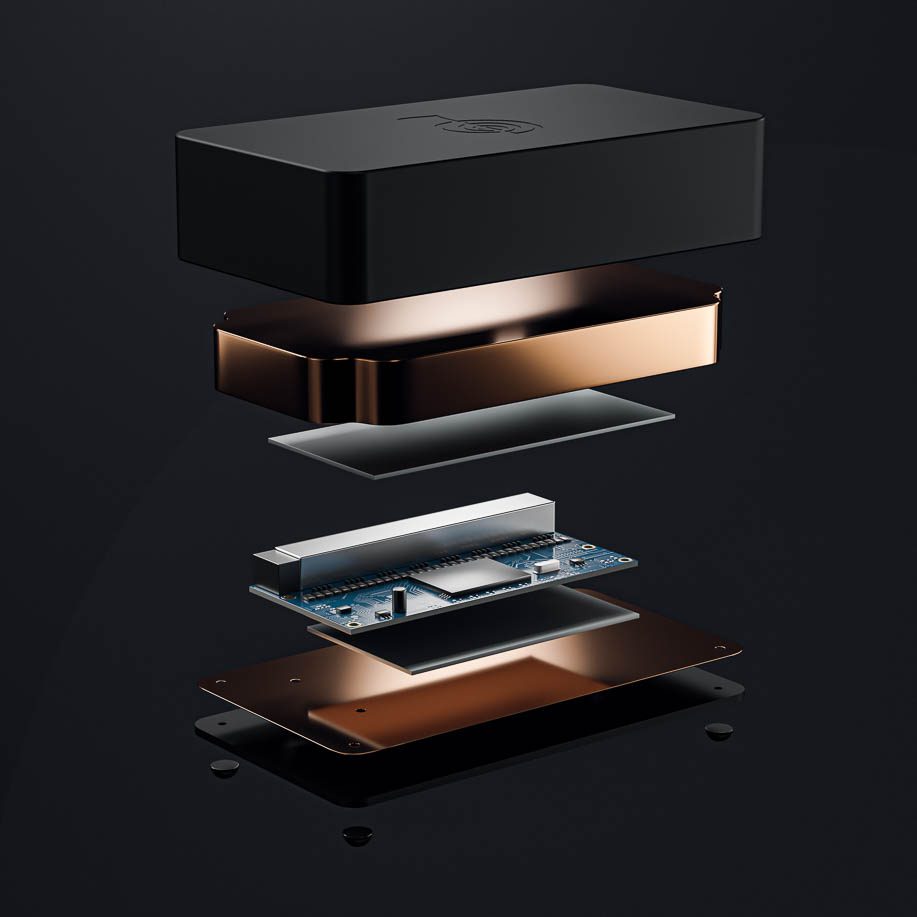
On opening the distinctly plush packaging and extracting these attractively hewn devices, I was a little surprised to find that neither of Reiki Audio’s SuperSwitches resemble the examples that other audio manufacturers, and the world of networking, describe as a ‘switch’. All of the latter have multiple ports; some like the Innuos PhoenixNET only have four but the majority stick with the eight found on the commercial switches that they are usually based on. Reiki’s switches have a single input and an equal amount of outputs so they function more like a filter but are in fact network switches under the skin.
It has become apparent that using multiple network switches in a cascade has positive effects in a streaming audio system because each one reduces the high frequency noise that abounds on data networks, noise which inevitably infiltrates our streaming devices and makes its way into the audio signal. The best way to improve the sound of a streaming system is to reduce this noise by whatever means possible, some such as Network Acoustics do it with a passive filter while rather more – including Ansuz, Melco, and English Electric – have taken the switch route.
Eureka
Reiki founder Nigel Bell comes from an IT background and like many others doubted the benefit of using a network switch in a streaming system until he tried a cheap example and had an epiphany. He expected to hear nothing or nothing more than a subtle change but in his words “it simply wasn’t”. That was in 2019 when he was working on an equipment rack that not only sounded good but looked good enough to put in a living room, and this revelation forced a change of approach and resulted in the Reiki SuperSwitch range.
Nigel’s thinking is that an audio streaming switch does not need multiple ports. In many instances there is only a streamer in the system so all it needs is a feed from the network. So he takes a regular eight port switch and shields the unused ports to stop the EMI/RFI noise from getting inside the switch, then removes any indicator lights because of noise that they might create within the circuitry and because RFI gets into the casework via the holes around the lights. Hence the solid appearance of the Reiki casework.
There are two variants on the Reiki SuperSwitch, the Master and Servant. They look identical but the Master incorporates copper shielding and an RFI/EMI absorber within the aluminium casing whereas the Servant does not. The latter is designed for use close to the router and the Master close to the streamer. Both units do the same job of reducing the amount of noise on the Ethernet connection but the extra shielding and RFI/EMI absorber in the Master make it a more effective noise killer.
Power Supplies
The SuperSwitches are available with a basic 5V power supply at £649 for the Servant or £949 for the Master but Reiki make the Pro 5V linear power supply which sells for £849 on its own or £1,399 with a Servant and £1,699 with a Master. The ultimate Reiki package is what we are considering here, the SuperSwitch Master Pro and Servant Pro which comes in at £2,999 for the four boxes. As yet, Reiki do not offer its own Ethernet cable but it holds that plastic plugs are generally superior to the metal ones found on most high end cables because metal breaks the galvanic isolation that is incorporated in each switch.
Build quality is to a high standard with 3mm thick aluminium casework in an anodised black finish. Both Master and Servant look identical so there are labels on the base of each to indicate which is which. Connection between the Pro power supply and switch is with a 50cm braided cable that locks onto the PSU. The in/out indicators on the switch are laser cut into the casework next to each port but it should work either way round.

The presence of just two connections on the SuperSwitch means that those of us with music servers to include in the network have to use an output from the router to connect the server, with a second cable going to the SuperSwitch and thence to the streamer. Alternatively with servers that have a player output you could place the SuperSwitch between it and the streamer, but this would require that the server be on in order to play Qobuz, Tidal etc. I started by putting the SuperSwitch Master in the former arrangement with both SuperSwitch and Melco N10 server connected to an English Electric 8Switch (with Chord GroundARAY onboard) so that the SuperSwitch ended up close to my Lumin U2 Mini streamer. In this situation adding the Master brought openness, clarity, air and shine to ‘Babylon Sisters’ (Steely Dan). It clearly drops the noise floor and gets you a step closer to the music.
Profound Change
In a more conventional arrangement without the EE 8Switch and with both streamer and server connected to a Cisco 2960 switch, introducing the SuperSwitch brought about a more profound change with backgrounds becoming notably quieter and the sound being purer, more relaxed and with greater focus to the imaging. The latter took on a distinctly three dimensional character and nuances came out in the performance that were not clear without the Master in the network. Adding the SuperSwitch Servant to this arrangement also proved highly beneficial with a further increase in image solidity alongside a tremendous sense of presence, it felt like the vocalist was in the room. Going back to ‘Babylon Sisters’ revealed that timing too had become clearer and that it was easier to differentiate between the two guitars in the mix.
Introducing the SuperSwitch Master into a Qobuz stream made Bonnie Raitt’s ‘Too Long at the Fair’ even more beautiful thanks to enhanced dynamics, greater clarity and all round separation and transparency. Adding the Slave to this chain brought more intricacy to the sound, greater purity of voice and a better sense of involvement. It essentially does the same thing as the Master but to a lesser degree, which given that they are so similar is no surprise, what it does prove is that cascading switches works and works well. Introducing the EE 8Switch/GroundARAY into this same network had more of a darkening and calming effect while also enhancing timing which is a classic Chord Co/English Electric characteristic.
Opening Up
Approaching this the other way round with the 8Switch in circuit and adding the SuperSwitch Master brought about an opening up of the sound thanks to a more detailed and better timed presentation. Adding the Servant to this chain increased image width and relaxed the sound, which was a different result to that heard earlier but similar to adding the 8Switch to Master and Servant, wherein you go from two switches to three. Cascading clearly works.
I had one issue with the SuperSwitches however which is that, when sitting atop their accompanying power supplies, they aren’t heavy enough to offset the weight of the chunkier Ethernet cables, and can end up tipped back. I guess the thing would be to support the cables (not always easy with this type of cabling), or use the lighter cabling that typically comes with the non-metal RJ45 plugs found on unshielded cables, or simply to move the switch to the front of the PSU top. I was using the opposite which might have undermined results although all they need is for the shielding not to be connected at one end to maintain galvanic isolation.
What it says on the box
I also listened to the Reiki switches with an AURALiC ARIES G1 streamer and found that they are very good at unearthing quieter details in almost any piece of music, especially leading edges which are picked from instruments even when they are low in the mix. This was apparent on the cymbal in Arab Strap’s ‘Packs of Three’ and has the effect of making the tempo more clear. Adding just the SuperSwitch Master to the link between Cisco switch and a Melco N5 (USB out to iFi Pro iDSD Signature DAC) had the same effect of adding definition to leading edges which produced a tighter, more solid sound in which it was easier to hear details like effects on the vocal.
The build and finish on the Reiki SuperSwitches is impressive. I particularly like the way that the symbol is laser cut into the lid for instance, and more importantly they do what it says on the website. They reduce the amount of RF/EMI noise that gets from the network into the audio signal that comes out of your streamer or DAC, and that in turn means a more natural and engaging sound that makes you want to listen louder and longer.
Technical specifications
- Type Streaming audio network switch
- LAN Ethernet ports Two (via RJ45)
- Fibre optic ports none
- Clock 25MHz
- Packet data buffer 128KB
- Features Separate linear power supply
- Finish Anodised black
- Dimensions (H×W×D) SuperSwitch: 45 × 182 × 100mm
Power supply: 68 × 250 × 138mm - Weight SuperSwitch Servant: 600g
SuperSwitch Master: 650g - Power supply 2.5kg
- Price £2,999
Manufacturer
Reiki Audio Ltd
+44(0)7880 500999
Tags: FILTERING NETWORK SWITCH REIKI AUDIO SUPERSWITCH MASTER PRO + SERVANT PRO
By Jason Kennedy
More articles from this authorRead Next From Review
See all
PrimaLuna EVO 100 phono preamplifier
- Apr 22, 2024

Melco Audio N1-S38 music server
- Mar 27, 2024











